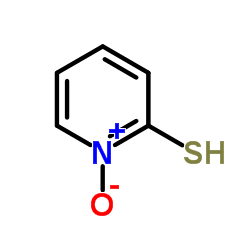Pyrithione

Pyrithione structure
|
Common Name | Pyrithione | ||
|---|---|---|---|---|
| CAS Number | 1121-31-9 | Molecular Weight | 127.164 | |
| Density | 1.3±0.1 g/cm3 | Boiling Point | 350.2±15.0 °C at 760 mmHg | |
| Molecular Formula | C5H5NOS | Melting Point | 70-72 °C | |
| MSDS | Chinese USA | Flash Point | 165.6±20.4 °C | |
| Symbol |

GHS06 |
Signal Word | Danger | |
|
Hypoxia lowers SLC30A8/ZnT8 expression and free cytosolic Zn2+ in pancreatic beta cells.
Diabetologia 57(8) , 1635-44, (2014) Hypoxic damage complicates islet isolation for transplantation and may contribute to beta cell failure in type 2 diabetes. Polymorphisms in the SLC30A8 gene, encoding the secretory granule zinc transporter 8 (ZnT8), influence type 2 diabetes risk, conceivably... |
|
|
ELEMENTAL SELENIUM GENERATED BY THE PHOTOBLEACHING OF SELENOMEROCYANINE PHOTOSENSITIZERS FORMS CONJUGATES WITH SERUM MACROMOLECULES THAT ARE TOXIC TO TUMOR CELLS.
Phosphorus. Sulfur. Silicon Relat. Elem. 67 , 311, (1992) Elemental selenium generated by the photobleaching of selenomerocyanine dyes forms conjugates with serum albumin and serum lipoproteins that are toxic to leukemia and selected solid tumor cells but well tolerated by normal CD34-positive hematopoietic stem and... |
|
|
Fusaric acid induces a notochord malformation in zebrafish via copper chelation.
Biometals 28 , 783-9, (2015) Over a thousand extracts were tested for phenotypic effects in developing zebrafish embryos to identify bioactive molecules produced by endophytic fungi. One extract isolated from Fusarium sp., a widely distributed fungal genus found in soil and often associa... |
|
|
A tautomeric zinc sensor for ratiometric fluorescence imaging: application to nitric oxide-induced release of intracellular zinc.
Proc. Natl. Acad. Sci. U. S. A. 101(5) , 1129-34, (2004) Zinc is an essential metal ion for human growth and development, the disruption of cellular Zn(2+) homeostasis being implicated in several major disorders including Alzheimer's disease, diabetes, and cancer. The molecular mechanisms of Zn(2+) physiology and p... |
|
|
Photodegradation of mercaptopyridine-N-oxide biocides.
Arch. Environ. Contam. Toxicol. 8(3) , 355-68, (1979)
|
|
|
Mercaptopyridine-N-oxide, an NADH-fumarate reductase inhibitor, blocks Trypanosoma cruzi growth in culture and in infected myoblasts.
FEMS Microbiol. Lett. 175(2) , 217-21, (1999) The enzyme NADH-fumarate reductase is not found in mammalian cells but it is present in several parasitic protozoa including Trypanosoma cruzi, the parasite that causes Chagas' disease. This study shows that the drug 2-mercaptopyridine-N-oxide (MPNO) inhibits... |
|
|
Pharmacokinetics and biodistribution of 99mTc N-MPO in healthy human volunteers.
Clin. Nucl. Med. 39(1) , e14-9, (2013) Tc N-MPO ([Tc N(MPO)(PNP5)]: HMPO = 2-mercaptopyridine N-oxide, and PNP5 = N-ethoxyethyl-N,N-bis[2-(bis(3-methoxypropyl)phosphino)ethyl]amine) is a new Tc radiotracer useful for myocardial perfusion imaging. This study was designed to determine its pharmacoki... |
|
|
Aldrichimica Acta 20 , 35, (1987)
|
|
|
J. Chem. Res. Synop. , 30, (1990)
|
|
|
J. Biopharm. Sci. 1 , 331, (1990)
|